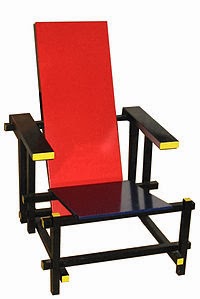Following
Alvar Aalto’s discoveries were the couple, Ray and Charles Eames. Charles came
from an architectural background whilst Ray came from a background of painting
and weaving as well as the new developing Abstract expressionism. They
travelled to Europe and were both exposed to the works of the Modern Movement,
Mies van der Rohe, Le Corbusier and Gropius.
 Their
breakthrough was when they won the Organic
Design in home furnishings Competition which was held at the Museum of
Modern Art New York in 1940. This competition sought new contemporary forms of
home furnishings, upholstery and related items. The winners were Eames and Eero
Saarinen who had collaborated to form an organic curved wooden shell chair that
united beauty with comfort. It was a new idea of design in contrast with the
harsh, geometric forms which were being seen at the moment of the Industrial
Style, and it was that factor which made them win the competition.
Their
breakthrough was when they won the Organic
Design in home furnishings Competition which was held at the Museum of
Modern Art New York in 1940. This competition sought new contemporary forms of
home furnishings, upholstery and related items. The winners were Eames and Eero
Saarinen who had collaborated to form an organic curved wooden shell chair that
united beauty with comfort. It was a new idea of design in contrast with the
harsh, geometric forms which were being seen at the moment of the Industrial
Style, and it was that factor which made them win the competition.
The
discoveries made by Ray and Charles Eames in the bending of wood got them a
commission from the US Navy to develop plywood splints, stretchers and glider
shells which were moulded by heat and high pressure. Their revolutionary
proposals were state of the art in manufacturing technique, firstly the
moulding of plywood into complex curves and also the use of cycle welding which
enables metal and wood to be joined by the electronic bonding process. At this
time there were a lot of advancements in technology which made these techniques
possible. Such example could be seen in:
Plywood
splints commissioned by US Navy
CTW
table and screen and LCW plywood chair
They
did not only produce furniture and necessities needed by the war but also
children’s toys and they used the same techniques which made these works
immediately recognisable as Eames creations. The fact that they were making use
of bent wood it made their products strong even though they had a light weight
appearance to them.
In
early 1940’s Charles Eames used to work for MGM in creating movie sets and also
working with his wife in creating and developing the Kazam machine. It was the
machine that made all their creations possible. Although in early designs they
had to split the wood at specific points so that the mould would not burst.

The
Kazam Machine and Chair Shell Experiments, designed 1941-45, moulded plywood,
metal, and rubber.
Once
they had mastered the moulding technique Ray and Charles Eames moved onto
another material thus created the fibreglass moulded chairs series. This way
they had provided a universal seat shell that could be mass produced therefore
it was cheaper to the consumer and it could be applied to a variety of bases.
Their designs were so innovative that we still see them in today.
Eames
plastic shell chair with various bases 1948-1950.
Eames
Wire Mesh Chair 1951-1953.
Plastic
Mould of La Chaise 1948.
Today
we consider these designs as elegant and a sense of style in which whoever has
one wants to show a statement of lifestyle and living. I am not talking about
only the Eames chairs but also other innovative designs such as Arne Jacobsen’s
famous Egg and Swan Chair. Said designs often go unnoticed when we watch a movie
because they still blend well with our present lifestyle and are ageless due to
their organic forms. So I did some research about these designs so that I can
point out in which movies they were shown, but the list was much longer than I
expected when I came across Anne-Sophie’s blog in which she gives a detailed
analysis. This blog can be found at: http://www.retrofurnish.com/blog/en/2012/08/design-in-movies-week-2/
Some
examples consist of:
 Eero
Saarinen’s Eero Chair which is a
reminiscent of the chair by which he had won the MOMA competition with Charles
Eames but this time it is more refined, with more padding and the use of chrome
for the legs.
Eero
Saarinen’s Eero Chair which is a
reminiscent of the chair by which he had won the MOMA competition with Charles
Eames but this time it is more refined, with more padding and the use of chrome
for the legs.
We
also have the Pedestal Chair which
was innovative in its own way. This was due to the fact that it was produced to
have one base instead of four legs which gave a sense of lightness.
 These
two stylish chairs are the Swan and Egg Chairs
1957-1958 by Arne Jacobsen which were created as a whole with the Arne Jacobsen Royal Hotel Copenhagen 1956-1960.
These
two stylish chairs are the Swan and Egg Chairs
1957-1958 by Arne Jacobsen which were created as a whole with the Arne Jacobsen Royal Hotel Copenhagen 1956-1960.
These
are the Panton Chair 1960 and Cone Chair 1958 by Verner Panton.
Vitra Design Museum. UN. Organic Armchair Charles Eames and
Eero Saarinen [online] Available at: http://www.design-museum.de/en/collection/100-masterpieces/detailseiten/organic-armchair-charles-eames-und-eero-saarinen.html
[Accessed on 23rd November 2013]
Herman Miller. Design
Story.[online] Available at: http://www.hermanmiller.com/products/seating/multi-use-guest-chairs/eames-molded-plywood-chairs.html
[Accessed on 23rd November 2013]
Tom. April 2013. Miniature Chair Man: Charles and Ray Eames
- Time-Life stools [online] Available at: http://www.miniaturechairman.com/8/category/charles%20and%20ray%20eames/1.html
[Accessed on 23rd November 2013]
Anne-Sophie. August 2012. Design in Movies: week
2. [online] Available at: http://www.retrofurnish.com/blog/en/2012/08/design-in-movies-week-2/
[Accessed on 23rd November 2013]










































,_Collezione_R._Jucker,_Milan,_Italy.jpg)

